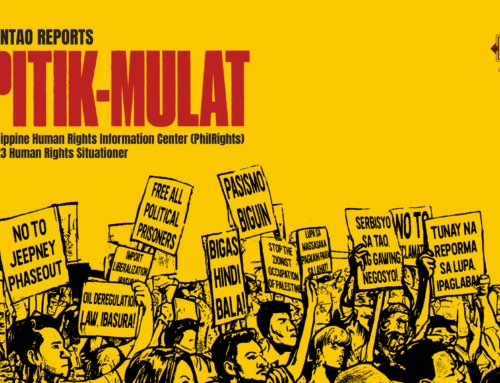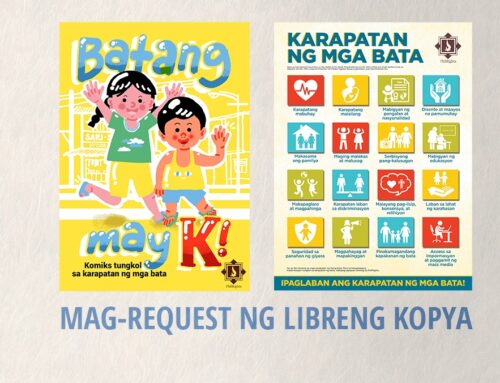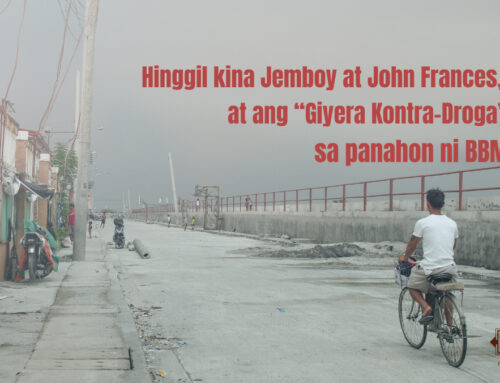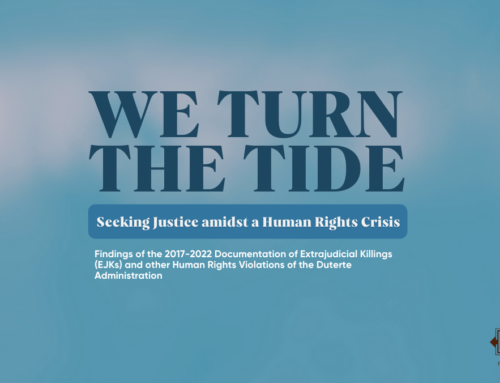by Isaac Linco
ABOUT THIS SERIES: It has been over 11 years since the inception of the Pantawid Pamilyang Pilipino Program (4Ps). This three-part series examines the ways it has or has not addressed the progressive realization of human rights of poor Filipinos, specifically their economic, social and cultural rights.
Part 1 reviews 4Ps’ design and intent as a poverty alleviation measure of the government.
Part 1: Poverty? 4Ps offers a solution
Contemporary discourse on human rights involves the accountability of the State, the primary duty bearer, to its citizens, the rights holders, to respect, protect, and fulfill human rights according to set international standards. These inherent entitlements allow the access of basic needs and other requirements to allow every person to grow and develop.
Because poverty hinders the fulfillment of human rights for many poor Filipinos,
addressing poverty and its many dimensions is therefore a State responsibility. It is stipulated in international human rights treaties, one of which is the International Covenant on Economic, Social, and Cultural Rights (ICESCR) which recognizes the “right of everyone to an adequate standard of living for himself and his family, including adequate food, clothing and housing, and to the continuous improvement of living conditions.”
Furthermore, other international instruments on Human Rights strengthen these provisions for special sectors of society such as the Convention on the Elimination of All Forms of Discrimination against Women (CEDAW) (1981) for women and the United Nations Convention on the Rights of the Child (UNCRC) (1989) for children.
The Philippines, as a State party to these instruments, is thus legally beholden to fulfill its international obligations on creating enabling conditions for ending poverty.
4Ps: Poverty Alleviation via Conditional Cash Transfers
The Pantawid Pamilyang Pilipino Program (4Ps) is the Philippines’ version of a conditional cash transfer scheme implemented in countries such as Brazil and Mexico. In broad terms, 4Ps intends to help the poorest households in the Philippines by providing cash grants for meeting their immediate needs and investing in human capital.
Conceptualized in 2007 and implemented in 2008 during the presidency of now House Speaker Gloria Macapagal-Arroyo, 4Ps was intended to help put an end to intergenerational poverty to beneficiary households, subject to compliance with program conditionalities.
The program was designed to address the worsening poverty situation in the country and meet the Millennium Development Goals (MDGs), the predecessor of the Sustainable Development Goals (SDGs).
The main feature of the program is the regular cash transfer scheme to family beneficiaries who must satisfy specific health and education requirements as designed by the program. The following are the conditions for the beneficiaries as monitored by the Department of Social Welfare and Development, program’s lead agency:
- Children 6-18 years old enroll in primary/secondary schools or equivalent Alternative Learning System / Alternative Delivery Method, and have at least 85% school attendance;
- Children 3-5 years old attend daycare/preschool program with at least 85% school attendance;
- Children 0-5 years old get regular preventive health check-ups, growth monitoring and vaccines;
- Pregnant women get pre-natal care and attended by skilled/professional health worker during child birth. Mothers who have given birth get post-natal care in accordance with the standard DOH protocol;
- Children 6-14 years old must receive de-worming pills twice a year; and
- Parents/guardians attend the monthly Family Development Sessions (FDS) where topics on effective parenting, husband and wife relationships, child development, laws affecting the Filipino family, gender and development and home management are being discussed.
Beneficiaries are identified through the Listahanan, formerly the National Household Targeting System for Poverty Reduction, while the targeted cities and municipalities are identified though their poverty incidences.
Poor households with children 0 to 18 years old and a pregnant member at the time of the survey are qualified to become beneficiaries. Household beneficiaries compliant to the set conditionalities are entitled to almost Php 2,000 monthly cash grant to cover the education and health needs of the family and children. In 2017, the government also added a rice subsidy of Php 600 per month. To offset the effects of the Tax Reform for Acceleration and Inclusion (TRAIN) Law, an additional monthly subsidy of Php 200.00 was implemented in 2018, which is set to increase to Php 300 for 2019 and 2020.
From a target of 6,000 families during its pilot implementation in 2007, the total 4Ps coverage has increased to 4.3 million households, with a budget of Php 89 Billion in 2018, making it the most expensive anti-poverty program of the Philippine government to date. It now covers 1,483 municipalities 144 cities, and 80 provinces.
4Ps should not be seen as a comprehensive strategy towards poverty reduction, despite its scope and price tag
Has 4Ps Reduced Inequalities?
Inequality may be seen as differences in the attainment of wealth or opportunities among people. Reducing the gap between the rich and poor by providing enabling conditions for the latter is the crux of any development program. The program, as it was designed, aims to reduce inequalities in the country in terms of access to basic needs and social services particularly education and health.
As a short-term strategy of addressing income inequalities, the cash transfers aim to support poor families in purchasing their daily basic needs through additional income. According to a 2011 study, household incomes of beneficiaries increased by 12.6% since the implementation of 4Ps. This increase of income by virtue of cash infusion, according to estimates, can “reduce the poverty rate in program areas by 2.6 percentage points in a year, the income gap by 3.6 percentage points, and the severity of poverty in program areas by 2.9 percentage points” according to the study authors. While these figures are theoretical for the target cities and municipalities, the potential is there to increase the economic capacities of poor families and improve their living conditions.
In the long run, 4Ps sees the need to invest in children’s survival and development by ensuring greater access to universal education and health services. These children, in turn, are expected to be better equipped to participate in society by qualifying for better socio-economic opportunities such as higher education and decent work, thus ending the cycle of intergenerational poverty.
All that said, 4Ps should not be seen as a comprehensive strategy towards poverty reduction, despite its scope and price tag. As embodied by the defining word in its name, its graduating beneficiaries are expected to cross-over the poverty line. In its current design and implementation, it remains unable to address the deeply embedded structural inequalities in the country’s socioeconomic fabric.








